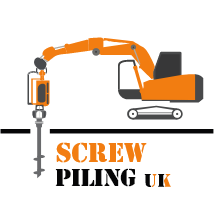Temporary Structures
THE OVERVIEW
Utilizing screw piles for Temporary Structures represents a modern and effective approach within the realm of foundation repair. It focuses on fortifying and stabilizing buildings afflicted with problems like subsidence, instability, or ground settlement. This technique proves particularly beneficial when conventional methods risk causing excessive damage to the environment, disruption to occupants, or when they prove inadequate given the site’s distinctive conditions or soil characteristics.
The process of integrating screw piles into projects requiring temporary structures is thorough and involves a series of well-defined steps, each vital to the success of the foundation stabilization effort. Initially, a detailed assessment of the foundation and the surrounding soil is conducted to understand the extent of the damage and the underlying causes.
The screw pile installation process is particularly suited for temporary structures due to its rapid installation and removal capabilities, minimal soil disturbance, and the reusability of the piles. This method provides a robust foundation solution that can be adapted to various site conditions and removed with little trace once the structure is no longer needed.
THE BENEFITS
Quick Installation:
– Screw piles can be installed rapidly, making them ideal for time-sensitive projects or events.
Minimized Disturbance:
– The installation process is generally quiet with minimal vibration, causing little disruption to the surroundings.
Versatility:
– Screw piles are versatile and suitable for various soil types, making them adaptable to different construction environments.
Temporary and Reusable:
– Screw piles are easily removable, making them suitable for temporary structures. They can be reused in other locations as needed.
No Excavation Required:
– Unlike traditional foundations, screw piles don’t require extensive excavation, reducing the impact on the site.
Restricted Access Capability:
– Screw piles can be installed in areas with limited access, making them suitable for sites where space is constrained.
Environmentally Friendly:
– The installation process generates minimal waste and disturbance to the ecosystem, promoting a more environmentally friendly construction method.
Cost-Effective:
-Screwpiles can offer cost savings compared to traditional foundation methods due to their efficiency and ease of installation.
Stable Foundation:
-Once installed, screw piles provide a stable and secure foundation for the temporary structure, ensuring its safety and durability.
Reduced Site Cleanup:
-With minimal excavation and debris, the overall site cleanup is simplified and requires less effort.
Adaptable to Various Structures:
-Screw piles can support a variety of temporary structures, including stages, tents, event structures, or temporary buildings
THE PROCESS
Site Evaluation
Initially, conduct a thorough assessment of the installation site to identify any potential challenges, such as underground utilities or varying soil conditions. This step ensures the chosen location is viable for screw pile installation.
Selection of Screw Piles
Choose the appropriate screw pile design based on the load requirements of the temporary structure and the soil characteristics of the site. Screw piles vary in diameter, length, and the design of the helical plates (the “screws”) to suit different conditions and loads.
Installation Equipment
The equipment used for installation ranges from handheld devices for light-duty applications to hydraulic rigs mounted on trucks or excavators for heavier loads. The choice of equipment depends on the screw pile size and the access constraints of the site.
Installation Process
The screw piles are installed by applying torque to the pile, causing it to advance into the ground much like a screw into wood. The torque required is monitored to ensure it matches the design specifications, providing an indication of the pile’s load-bearing capacity.
Depth and Verification
The depth to which the screw pile is installed depends on achieving the required torque and reaching stable soil strata. This depth can vary significantly based on soil composition. Verification of the installation torque ensures that the piles will support the intended loads.
Structure Attachment
Once the screw piles are installed, the above-ground structure can be securely attached to the piles’ protruding heads. These heads are designed to facilitate various types of connections, allowing for a versatile range of temporary structures to be supported.
Projects with Temporary Structures
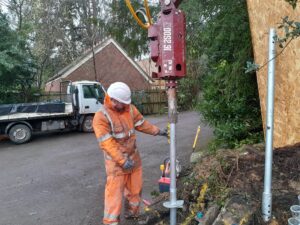
29 Beaucroft Lane, Wimborne
The Wimborne residential project, featuring a garage extension, concluded remarkably ahead of time in just 2 days instead of the planned week, resulting in a 56m² double garage. Utilising an 8-ton Kubota x60 Excavator and 17 screwpiles with a 5m average depth, this efficient completion was achieved in collaboration with MPS Building LTD.
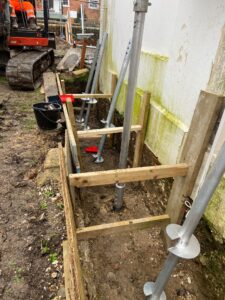
22 Crichel Mount, Sandbanks
In our recent residential extension project, 22 screwpiles were installed to strategically enhance the existing garage and terrace area. Executed by the dedicated team at Screwpiling UK for MPS Building Contractors, the renovation achieved an average depth of 6 meters for each 76mm diameter screwpile within a remarkable 1-week timeframe, surpassing expectations. The project utilized our 8-ton Kubota excavator, demonstrating efficiency and excellence in execution.
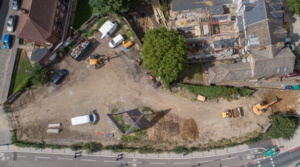
Rosebank Way, Acton
Nestled in North Acton, West London, within the London Borough of Ealing, Rosebank Way is at the heart of a dynamic revitalization, fuelled by the upcoming Elizabeth Line (Crossrail) from Acton Main Line. Serving as a catalyst for ongoing investment, the transit project is set to boost connectivity and has the potential to elevate property values and spur economic activity.
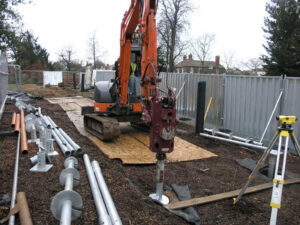
4 St James’ Villas, Winchester
Our recent residential extension project highlights our dedication to quality and efficiency. Despite challenges posed by restricted access, our specialized equipment, including the 65kg 700H Handheld Torque, enabled us to install 22 screwpiles at an impressive average depth of 6 meters.

